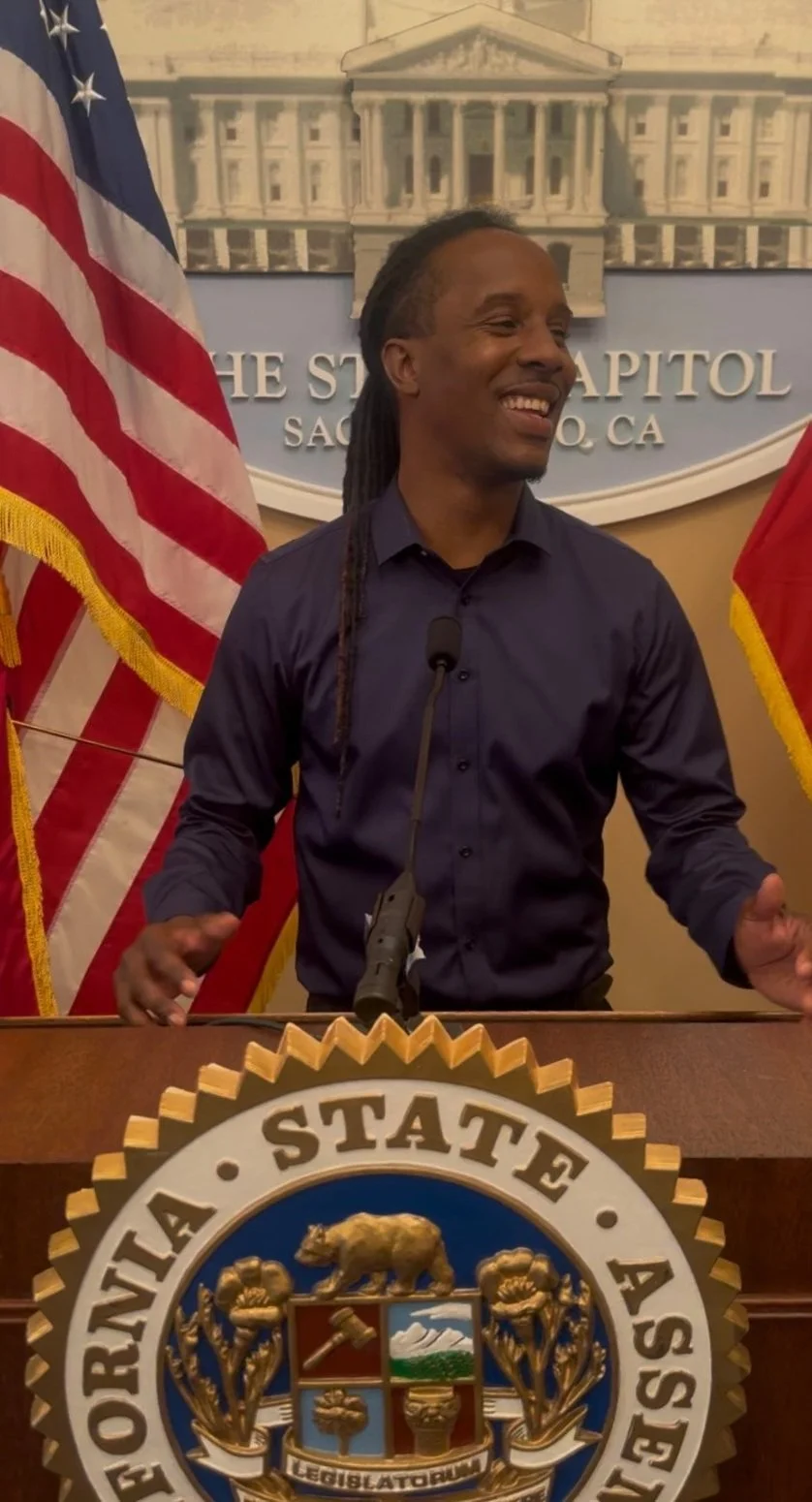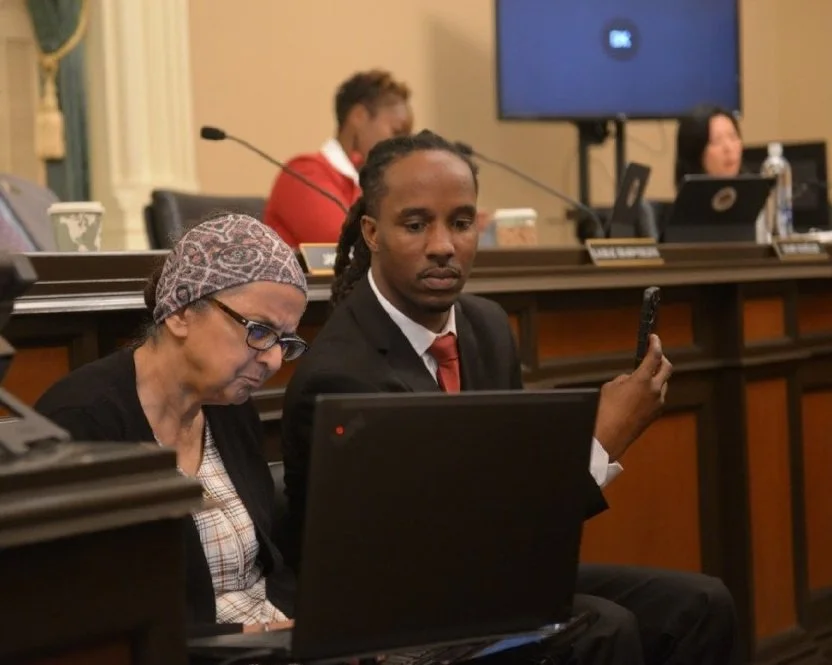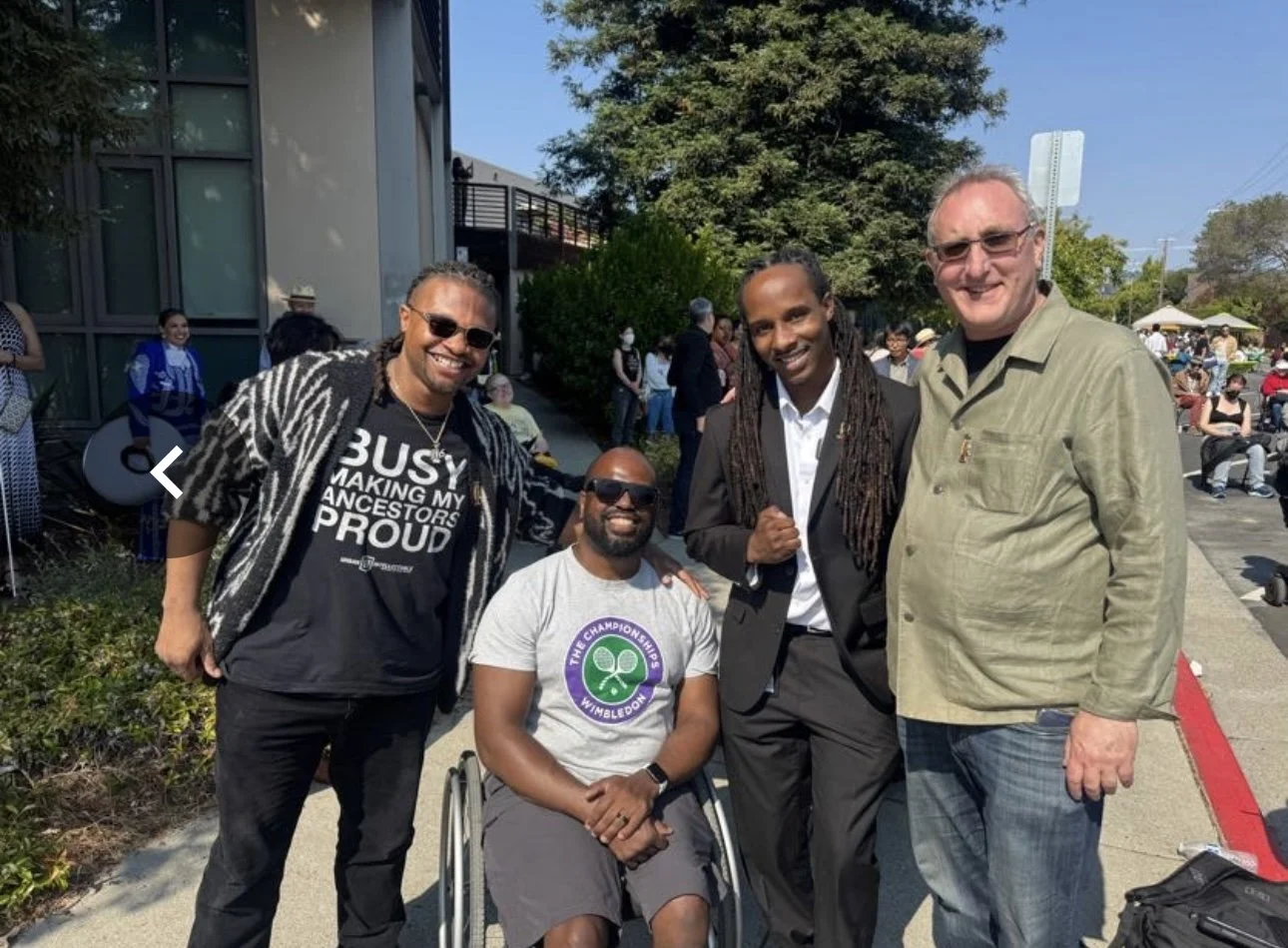By Tremmel Watson
Among other advocacy roles, Tremmel Watson works in the Public Policy unit at Disability Rights California and has presented at the California State Assembly.
I wasn’t born deaf. My hearing loss happened over time. When I was 4 years old, I nearly drowned in a swimming pool. The water pressure from that accident damaged my eardrums. The full impact took years to unfold.
I identify as a late-deafened adult. I lost my hearing after I had already acquired spoken language. Because of that, I was raised in the hearing world and developed language through listening and speaking before transitioning to visual forms of communication.
I can’t understand speech without visual support and rely on tools like CART (Communication Access Realtime Translation), captioning, and speech reading for access.
Even though my deafness came early, the fact that I first experienced the world as a hearing person shaped how I communicate, learn, and move through both Deaf and hearing spaces. I didn’t grow up signing or as part of the Deaf community, which makes my experience different from those who were born deaf or raised in Deaf culture from the start.
I was eventually identified as hard of hearing and fitted with hearing aids. Still, I struggled to catch everyday sounds like a knock at the door, someone calling my name, or a voice on the other end of a phone call. I relied heavily on reading lips and body language to fill in the gaps.
By the time I was incarcerated, the little hearing I had left was gone. I became completely deaf while inside the prison system, cut off from the sounds most people take for granted. I was suddenly in a world where every interaction became a struggle. Communication wasn’t just challenging. It was isolating.
I never attended a school for the deaf or received formal training in sign language or lipreading. My first exposure to American Sign Language (ASL) came through my aunt, who worked at S.T.E.P. (Strategies to Empower People), one of the largest employers of Deaf individuals in Northern California. My introduction to sign language came through a client named Pam, who used a few simple signs like “McDonald’s,” “coffee,” “water,” “hurt,” and “school.”
Tremmel in front of the California State Capitol Building in Sacramento with Matt Scott, a 4x Paralympian, 2x gold medalist, and founder of the Fly Without Limits Foundation. Through his foundation, Matt empowers others to break through barriers and find their purpose, emphasizing determination, support, and living life without limits.
Today I’m proficient in ASL, but captions are my primary and most effective form of communication access. I rely on CART, which stands for Communication Access Realtime Translation. CART provides live, clear, and accurate speech-to-text captions. With it, I can identify who is speaking, follow conversations, and stay engaged without missing context.
At first, I didn’t know I had the right to request CART captioning, just like someone might request an ASL interpreter.
That’s the problem. You can’t fight for an accommodation if you don’t know it exists.
Before I discovered CART, I often felt left out, despite being physically present. Imagine being in a meeting, trying to follow along by guessing through fragmented sounds. That was my reality.
And I’m not alone. This gap in awareness affects thousands of people. That’s why I speak up, because access delayed is opportunity denied.
Tremmel’s advocacy work includes working with captioning companies like InnoCaption (above) as well as the nonprofit Global Alliance of Speech-to-Text Captioning (below), both participants at the Hearing Loss Association of America convention in June 2025.
I’ve used both ASR (automated speech recognition) and CART, and the difference is night and day. Real-time human captioning doesn’t just give me words. It gives me tone, context, and clarity, the kind that only a human captioner can provide, especially in complex or dynamic environments. Accurate captions can mean the difference between simply being present and truly understanding what’s being said.
I currently work in the Public Policy unit at Disability Rights California, where I focus on policies that impact deaf and hard of hearing people. A major part of my work is making sure that different communication needs are recognized and supported.
Tremmel with Lynn Myer, the board director at the Global Alliance of Speech-to-Text Captioning, who is a real-time (voice) broadcast captioner who specializes in live television captioning for news and sports. She provides near-instant, highly accurate speech-to-text using voice recognition technology, converting spoken content into readable captions to ensure access for viewers who are deaf or hard of hearing.
Some people use sign language. Others rely on captions, hearing aids, or assistive technology. Accessibility shouldn’t be treated as an extra. It should be the standard across public services, healthcare, and education.
Losing my hearing changed how I move through the world, but it also gave me a sense of purpose. I want others to have access without having to fight for it.
Communication access is not a luxury. It is a right. Everyone deserves to be included. There is no equality without accessibility. We all have the right to be understood and to understand.
My advocacy also extends nationally, and I want to be clear that I support all forms of speech-to-text. I’m part of a caption advocacy organization whose mission is to be the leading authority on speech-to-text captioning. The Global Alliance of Speech-to-Text Captioning is a nonprofit that provides public education and resources on all captioning formats.
Its members include steno captioners, voice writers, post-production captioners, consumers, and industry professionals. The organization educates the public about captioning and promotes high standards of access.
Tremmel has also worked with the Prison Law Office, which represents people with disabilities in the California prison system.
My involvement with the National Court Reporters Association came through research I was doing while working with the Prison Law Office, which represents people with disabilities in the California prison system. I was retained as a consultant and drafted a legal declaration comparing CART to an automated captioning system proposed for use in correctional facilities.
As an expert in that federal case, I explained why human captioning via CART was the only proposed effective accommodation for deaf people in prison whose effective communication is written notes.
In addition to having serious problems with accuracy and inadequate display features, the proposed ASR lacked the speaker identification and environmental cues needed to make communication truly accessible. A deaf person should not be left guessing who is speaking or unaware of sounds that others around them hear automatically.
To be clear, I have seen ASR technology improve. Some systems now include speaker labels, and that is progress. But environmental context is more cognitive to capture. Knowing if a fire alarm just went off or someone whispered something across the room makes a difference, especially in high-stakes settings. I’m not opposed to innovation. I just believe we need to be honest about its limits.
At a celebration of the 35th anniversary of the Americans with Disabilities Act this month, Tremmel (second from right) with his Disability Rights California colleagues (from left): senior policy advocate Conrad Crump; Eric Harris, the associate executive director of external affairs; and CEO Andy Imparato.
Since 2024, I have served as a nonvoting subject matter expert in the Federal Communication Commission’s IP CTS (Internet Protocol Captioned Telephone Service) Caption Quality Metrics Working Group. In this role, I contribute both technical insight and lived experience.
My input helps evaluate captioning accuracy, delay, and usability across human and automated systems. I collaborate with captioning providers, researchers, and industry representatives to inform national standards that impact accessibility for deaf and hard-of-hearing consumers.
More recently, I advocated for California’s updated Essential Health Benefits plan, which now includes hearing aid coverage for both children and adults.
I see this article not just as a reflection of where I’ve been, but as the beginning of something ongoing. Hearing Health Foundation has invited me to contribute regular updates, and I plan to use this space to share advocacy work, legal updates, and broader thoughts on accessibility and disability rights. There’s more to be done, and I’m committed to helping keep these conversations going.
Tremmel Watson is a disability advocate and consultant with experience in assistive technology. He is based in Sacramento, California. Contact him at tremmel.watson@disabilityrightsca.org.












Which noises should we be aware of this holiday season?